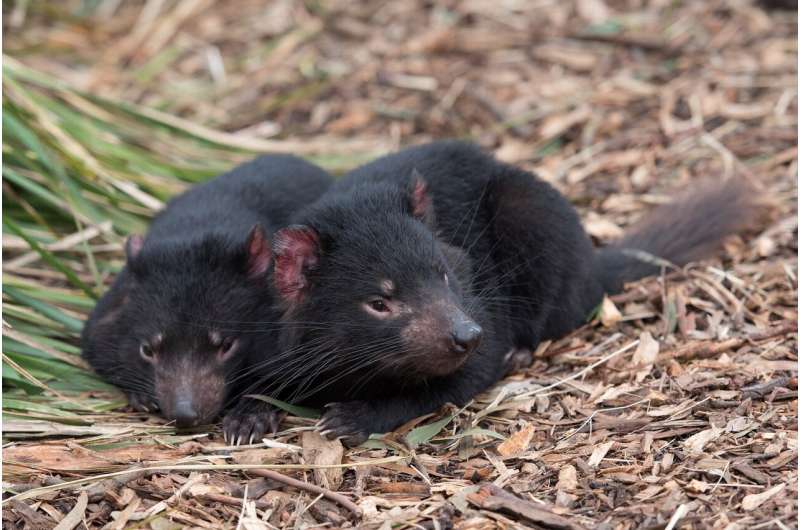Credit: Pixabay/CC0 Public Domain
Cholesterol-lowering drugs could help delay the spread of the deadly Tasmanian devil facial tumor disease (DFTD) and may help protect the endangered Australian marsupials from extinction, newly published research by QIMR Berghofer and Spanish scientists has suggested.
By studying the molecular and metabolic mechanisms that drive devil facial tumor disease, the researchers found tumor cells required a minimum amount of cholesterol to multiply. If cholesterol synthesis was drastically reduced, the tumors did not grow.
The research findings have been published in the journal Cell Reports.
The lead researchers, Dr. Manuel A. Fernández-Rojo and Dr. Maria Ikonomopoulou, conducted most of the study at QIMR Berghofer Medical Research Institute in Brisbane.
Devil facial tumor disease is a fatal, very aggressive form of transmissible cancer. It is spread through the transfer of living cancer cells when Tasmanian devils bite each other. However, the metabolic drivers underlying devil facial tumor disease have not been thoroughly studied until now.
Dr. Fernandez-Rojo said identifying the impact of manipulating the cholesterol content in DFTD cells led them to look at cholesterol lowering drugs as potential treatments.
Credit: Save the Tasmanian Devil Program
"Our laboratory experiments showed devil facial tumor disease cells grew and spread more, using glucose as a source of energy, if they were stimulated with drugs that activated the nuclear receptor LXR (Liver-X-receptor). LXR is involved in regulating cellular cholesterol levels," Dr. Fernández-Rojo said.
"We used this understanding of the biology that drives the disease to examine if statins, which are drugs that inhibit cholesterol synthesis, would stop the tumor cells multiplying.
"We found statins reduced the growth of the devil facial tumors in the laboratory and we believe more research should now be undertaken to see whether these cholesterol-lowering drugs could be used to inhibit, or at least slow, the growth of DFTD and hopefully help protect the species."
Dr. Maria Ikonomopoulou said the research findings might also have implications for malignant and highly aggressive cancers in humans.
"We know statins work on tumor cells in lab experiments, so we now want to expand our study of the drugs in stopping the spread of cancer tumors," Dr. Ikonomopoulou said.
"Human cancer cells undergo similar metabolic adaptation to grow as those exhibited by DFTD cells in our research.
"This raises the question of whether statins, which are currently prescribed for the treatment of cardiovascular disease and diabetes in humans, could also be used to help treat very aggressive human cancers such as melanoma, pancreatic or colon cancer."
The head of QIMR Berghofer's Cell and Molecular Biology department, Professor Grant Ramm, who was a co-author on the study said the findings highlight the benefits of researching a wide range of different diseases across species, because of the ultimate potential benefits for human health.
"This type of cell and molecular biology research, which is being conducted in laboratories across Australia, is critical for understanding the mechanisms of diseases and identifying new therapeutic interventions to treat not only existing health conditions, but also emerging health threats in the future," Professor Ramm said.
"Basic science research is vital in order to generate translational outcomes in the clinic, whether it's to treat people with chronic 21st century diseases, or the Tasmanian devil with DFTD."
According to Zoos Victoria, there are fewer than 15,000 Tasmanian devils left in the wild, which is an 80 percent drop in population since DFTD first emerged in the mid-1990s.
More information: Maria P. Ikonomopoulou et al. LXR stimulates a metabolic switch and reveals cholesterol homeostasis as a statin target in Tasmanian devil facial tumor disease, Cell Reports (2021). DOI: 10.1016/j.celrep.2021.108851
Journal information: Cell Reports
Provided by QIMR Berghofer Medical Research Institute

























